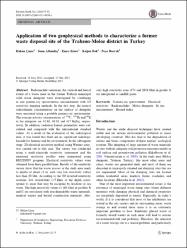| dc.contributor.author | Çınar, Hakan | |
| dc.contributor.author | Altundaş, Suna | |
| dc.contributor.author | Ersoy, Emre | |
| dc.contributor.author | Bak, Kağan | |
| dc.contributor.author | Bayrak, Neşe | |
| dc.date.accessioned | 2019-12-18T08:17:31Z | |
| dc.date.available | 2019-12-18T08:17:31Z | |
| dc.date.issued | 2015-07-17 | |
| dc.identifier.issn | 10.1007/s12665-015-4839-z | |
| dc.identifier.uri | https://hdl.handle.net/20.500.12440/1739 | |
| dc.description.abstract | Radionuclide variations, the vertical and lateral extent of a waste mass in the former Trabzon municipal solid waste dumpsite were investigated by combining in situ gamma-ray spectrometric measurements with 2D resistivity imaging methods. In the first step, the natural radioelement concentrations on the surface of dumpsite were measured using a portable gamma-ray spectrometer. The average activity concentrations of 238U, 232Th and 40K in the dumpsite are 42.68, 49.88 and 417 Bq/kg, respectively. In addition, radiation hazard parameters were calculated and compared with the international standard values. As a result of the evaluation of the radiological data, it was found that there are no significant radiologic hazards for humans and the environment. In the subsequent stage, 2D electrical resistivity method, using Wenner array, was carried out in this area. The survey was conducted using a multi-electrode resistivity instrument and the measured resistivity profiles were interpreted using RES2DINV program. Electrical resistivity values were obtained from three parallel lines. Results of the resistivity survey show that the waste masses in the study area reach to depths of about 18 m, with very low resistivity values less than 20 Xm. According to the 2D inverted resistivity sections, low resistivities (\7 Xm) at the depth corresponds to areas that may be occupied by leachate or sea water. The high resistivity values ([160 Xm) in profiles B and C are associated with non-degradable waste materials, medical wastes and buried construction materials. Also, very high resistivity zone (874 and 2636 Xm) in profile A are interpreted as landfill gases. | en_US |
| dc.language.iso | eng | en_US |
| dc.publisher | Springer-Environmental Earth Sciences | en_US |
| dc.relation.ispartofseries | ;1786054 | |
| dc.rights | info:eu-repo/semantics/openAccess | en_US |
| dc.subject | Gamma-ray spectrometer | en_US |
| dc.subject | Electrical resistivity | en_US |
| dc.subject | Radionuclides | en_US |
| dc.subject | Moloz dumpsite | en_US |
| dc.subject | In situ measurement | en_US |
| dc.subject | Hazard index | en_US |
| dc.title | Application of two geophysical methods to characterize a former waste disposal site of the Trabzon-Moloz district in Turkey | en_US |
| dc.type | article | en_US |
| dc.relation.publicationcategory | Makale - Uluslararası Hakemli Dergi - Kurum Öğretim Elemanı | en_US |
| dc.department | Fakülteler, Mühendislik ve Doğa Bilimleri Fakültesi, Jeofizik Mühendisliği Bölümü | en_US |
| dc.authorid | 0000-0002-5840-0352 | en_US |
| dc.contributor.institutionauthor | Altundaş, Suna | |


















